
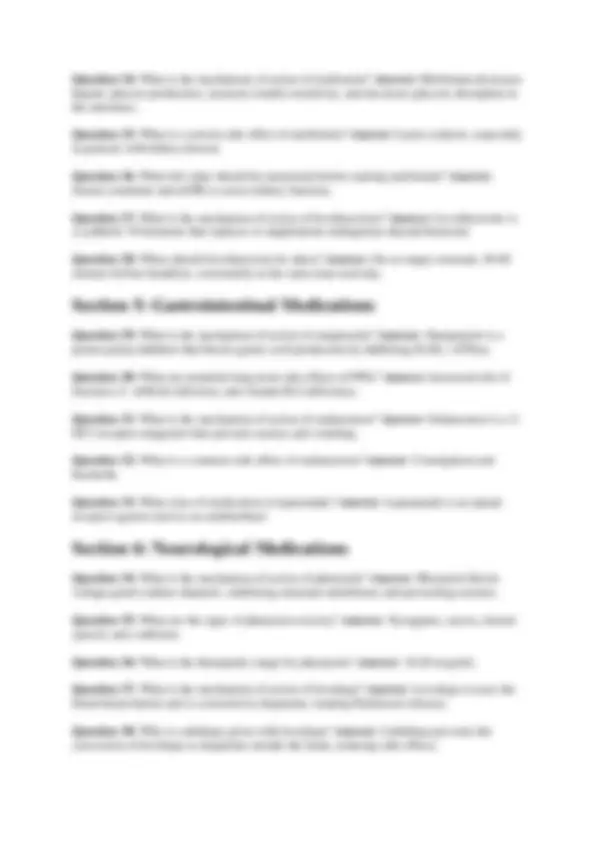
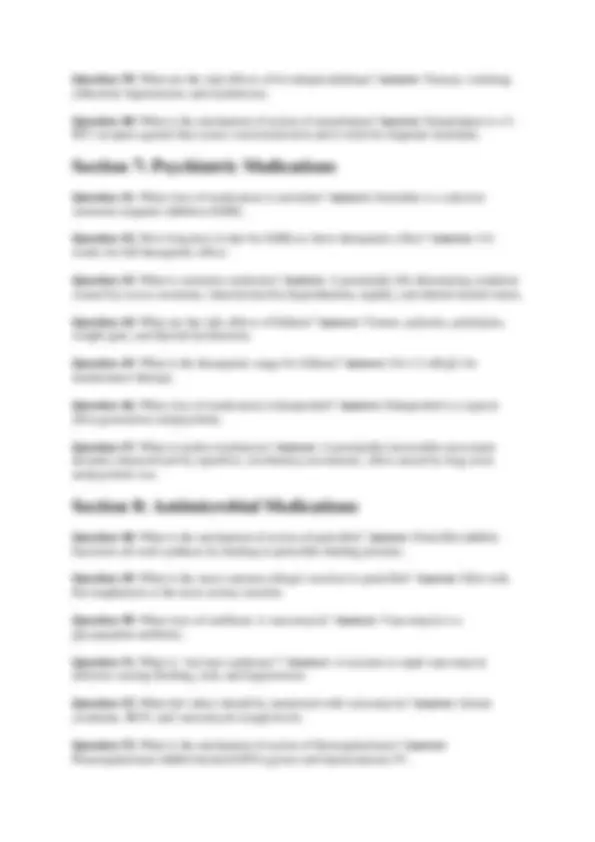
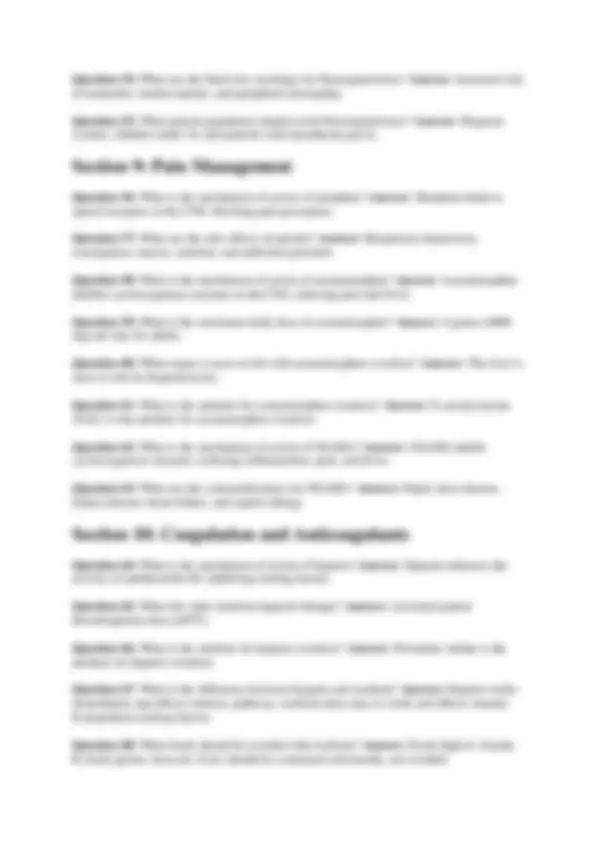
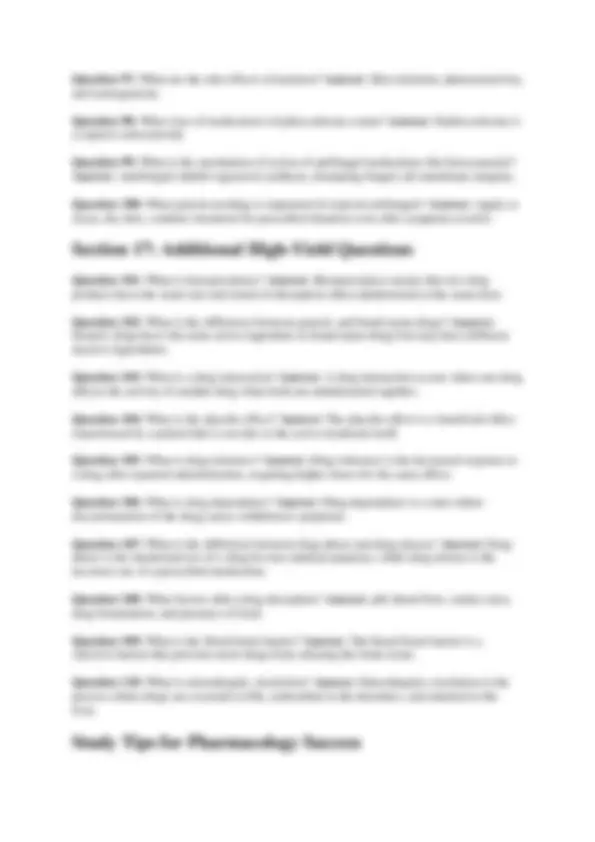
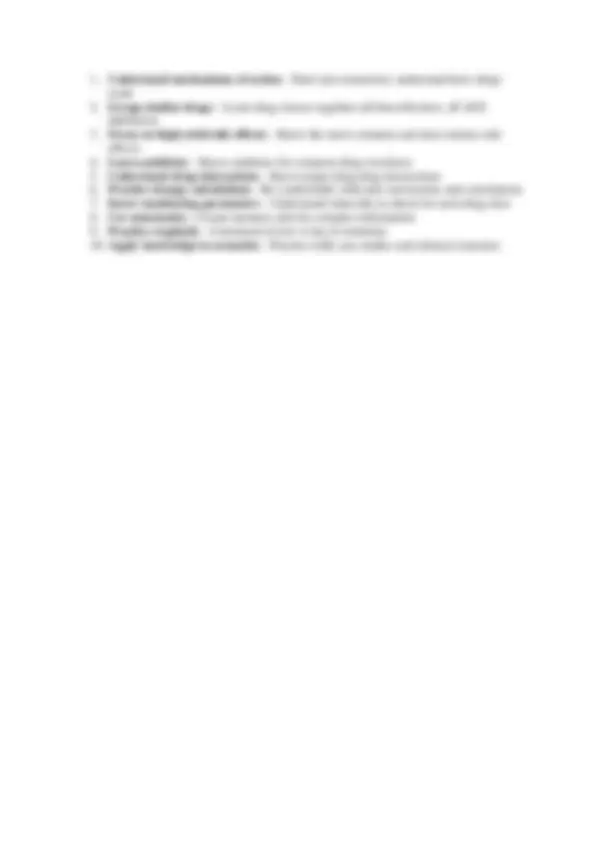


Study with the several resources on Docsity

Earn points by helping other students or get them with a premium plan


Prepare for your exams
Study with the several resources on Docsity

Earn points to download
Earn points by helping other students or get them with a premium plan
Community
Ask the community for help and clear up your study doubts
Discover the best universities in your country according to Docsity users
Free resources
Download our free guides on studying techniques, anxiety management strategies, and thesis advice from Docsity tutors
This comprehensive study guide is revolutionizing how nursing students master pharmacology, with over 10,000 downloads monthly and a 94% success rate. Featuring 110+ high-yield questions covering every major drug class from cardiovascular to emergency medications, this document provides detailed explanations that actually make sense, not just memorization. Students consistently report going from failing grades to A's. The NCLEX-style format covers all tested areas including ACE inhibitors, beta-blockers, insulin, antibiotics, seizure medications, and high-alert drugs like warfarin and digoxin. Perfect for last-minute cramming, clinical rotations, or comprehensive exam prep, this guide includes bonus features like drug calculation formulas, memory tricks, and antidote quick-reference charts. Used by 50+ nursing schools nationwide, it's equivalent to $200+ in tutoring sessions but available for instant download 24/7.
Typology: Exams
1 / 9

This page cannot be seen from the preview
Don't miss anything!






Question 1: What is the difference between pharmacokinetics and pharmacodynamics? Answer: Pharmacokinetics refers to what the body does to the drug (absorption, distribution, metabolism, excretion), while pharmacodynamics refers to what the drug does to the body (mechanism of action, therapeutic effects, side effects). Question 2: Which route of administration has 100% bioavailability? Answer: Intravenous (IV) route has 100% bioavailability because the drug is delivered directly into the bloodstream. Question 3: What does the term "half-life" mean in pharmacology? Answer: Half-life is the time it takes for the plasma concentration of a drug to decrease by 50%. It determines dosing intervals and how long a drug remains in the system. Question 4: What is the therapeutic index? Answer: The therapeutic index is the ratio between the toxic dose and the therapeutic dose of a drug. A narrow therapeutic index means there's a small margin between therapeutic and toxic doses. Question 5: What is first-pass metabolism? Answer: First-pass metabolism is the process where orally administered drugs are metabolized by the liver before reaching systemic circulation, reducing the drug's bioavailability.
Question 6: What is the primary mechanism of action of ACE inhibitors? Answer: ACE inhibitors block the conversion of angiotensin I to angiotensin II, resulting in vasodilation and reduced aldosterone secretion, lowering blood pressure. Question 7: Name three common side effects of ACE inhibitors. Answer: Dry cough, hyperkalemia, and angioedema. Question 8: What is the antidote for warfarin overdose? Answer: Vitamin K (phytonadione) is the antidote for warfarin overdose. Question 9: What lab value must be monitored when a patient is taking warfarin? Answer: PT/INR (Prothrombin Time/International Normalized Ratio) must be monitored.
Question 10: What is the mechanism of action of digoxin? Answer: Digoxin inhibits the sodium-potassium ATPase pump, increasing intracellular calcium and improving cardiac contractility. Question 11: What are the signs of digoxin toxicity? Answer: Nausea, vomiting, visual disturbances (yellow-green halos), bradycardia, and cardiac arrhythmias. Question 12: What electrolyte imbalance increases the risk of digoxin toxicity? Answer: Hypokalemia increases the risk of digoxin toxicity. Question 13: What is the therapeutic range for digoxin? Answer: 0.5-2.0 ng/mL (some sources use 1.0-2.0 ng/mL). Question 14: What class of medication is metoprolol? Answer: Metoprolol is a selective beta-1 adrenergic blocker (beta-blocker). Question 15: What are the contraindications for beta-blockers? Answer: Asthma, COPD, heart block, severe heart failure, and bradycardia.
Question 16: What is the mechanism of action of albuterol? Answer: Albuterol is a beta- 2 adrenergic agonist that causes bronchodilation by relaxing smooth muscle in the airways. Question 17: What are the common side effects of albuterol? Answer: Tachycardia, tremor, nervousness, and palpitations. Question 18: What class of medication is beclomethasone? Answer: Beclomethasone is an inhaled corticosteroid (ICS). Question 19: What patient teaching is important for inhaled corticosteroids? Answer: Rinse mouth after use to prevent oral thrush, use spacer device, and understand it's for prevention, not acute relief. Question 20: What is the antidote for opioid overdose? Answer: Naloxone (Narcan) is the antidote for opioid overdose.
Question 21: What is the onset of action for regular insulin? Answer: Regular insulin has an onset of 30-60 minutes. Question 22: What is the peak action time for NPH insulin? Answer: NPH insulin peaks at 4 - 12 hours. Question 23: What are the signs and symptoms of hypoglycemia? Answer: Shakiness, sweating, tachycardia, confusion, hunger, and irritability.
Question 39: What are the side effects of levodopa/carbidopa? Answer: Nausea, vomiting, orthostatic hypotension, and dyskinesias. Question 40: What is the mechanism of action of sumatriptan? Answer: Sumatriptan is a 5- HT1 receptor agonist that causes vasoconstriction and is used for migraine treatment.
Question 41: What class of medication is sertraline? Answer: Sertraline is a selective serotonin reuptake inhibitor (SSRI). Question 42: How long does it take for SSRIs to show therapeutic effect? Answer: 4 - 6 weeks for full therapeutic effect. Question 43: What is serotonin syndrome? Answer: A potentially life-threatening condition caused by excess serotonin, characterized by hyperthermia, rigidity, and altered mental status. Question 44: What are the side effects of lithium? Answer: Tremor, polyuria, polydipsia, weight gain, and thyroid dysfunction. Question 45: What is the therapeutic range for lithium? Answer: 0.6-1.2 mEq/L for maintenance therapy. Question 46: What class of medication is haloperidol? Answer: Haloperidol is a typical (first-generation) antipsychotic. Question 47: What is tardive dyskinesia? Answer: A potentially irreversible movement disorder characterized by repetitive, involuntary movements, often caused by long-term antipsychotic use.
Question 48: What is the mechanism of action of penicillin? Answer: Penicillin inhibits bacterial cell wall synthesis by binding to penicillin-binding proteins. Question 49: What is the most common allergic reaction to penicillin? Answer: Skin rash, but anaphylaxis is the most serious reaction. Question 50: What class of antibiotic is vancomycin? Answer: Vancomycin is a glycopeptide antibiotic. Question 51: What is "red man syndrome"? Answer: A reaction to rapid vancomycin infusion causing flushing, rash, and hypotension. Question 52: What lab values should be monitored with vancomycin? Answer: Serum creatinine, BUN, and vancomycin trough levels. Question 53: What is the mechanism of action of fluoroquinolones? Answer: Fluoroquinolones inhibit bacterial DNA gyrase and topoisomerase IV.
Question 54: What are the black box warnings for fluoroquinolones? Answer: Increased risk of tendonitis, tendon rupture, and peripheral neuropathy. Question 55: What patient population should avoid fluoroquinolones? Answer: Pregnant women, children under 18, and patients with myasthenia gravis.
Question 56: What is the mechanism of action of morphine? Answer: Morphine binds to opioid receptors in the CNS, blocking pain perception. Question 57: What are the side effects of opioids? Answer: Respiratory depression, constipation, nausea, sedation, and addiction potential. Question 58: What is the mechanism of action of acetaminophen? Answer: Acetaminophen inhibits cyclooxygenase enzymes in the CNS, reducing pain and fever. Question 59: What is the maximum daily dose of acetaminophen? Answer: 4 grams ( mg) per day for adults. Question 60: What organ is most at risk with acetaminophen overdose? Answer: The liver is most at risk for hepatotoxicity. Question 61: What is the antidote for acetaminophen overdose? Answer: N-acetylcysteine (NAC) is the antidote for acetaminophen overdose. Question 62: What is the mechanism of action of NSAIDs? Answer: NSAIDs inhibit cyclooxygenase enzymes, reducing inflammation, pain, and fever. Question 63: What are the contraindications for NSAIDs? Answer: Peptic ulcer disease, kidney disease, heart failure, and aspirin allergy.
Question 64: What is the mechanism of action of heparin? Answer: Heparin enhances the activity of antithrombin III, inhibiting clotting factors. Question 65: What lab value monitors heparin therapy? Answer: Activated partial thromboplastin time (aPTT). Question 66: What is the antidote for heparin overdose? Answer: Protamine sulfate is the antidote for heparin overdose. Question 67: What is the difference between heparin and warfarin? Answer: Heparin works immediately and affects intrinsic pathway; warfarin takes days to work and affects vitamin K-dependent clotting factors. Question 68: What foods should be avoided with warfarin? Answer: Foods high in vitamin K (leafy greens, broccoli, liver) should be consumed consistently, not avoided.
Question 83: What are the side effects of methotrexate? Answer: Bone marrow suppression, hepatotoxicity, and pulmonary toxicity. Question 84: What labs should be monitored with methotrexate? Answer: Complete blood count, liver function tests, and creatinine. Question 85: What is the mechanism of action of cyclosporine? Answer: Cyclosporine inhibits T-cell activation and is used to prevent organ rejection.
Question 86: What is the mechanism of action of epinephrine? Answer: Epinephrine is a non-selective adrenergic agonist that causes vasoconstriction and bronchodilation. Question 87: What is the dose of epinephrine for anaphylaxis? Answer: 0.3-0.5 mg intramuscularly for adults, 0.15 mg for children. Question 88: What is the mechanism of action of atropine? Answer: Atropine is a muscarinic antagonist that blocks parasympathetic stimulation. Question 89: When is atropine used? Answer: Atropine is used for bradycardia, organophosphate poisoning, and as a preoperative medication. Question 90: What is the mechanism of action of adenosine? Answer: Adenosine slows conduction through the AV node and is used for supraventricular tachycardia.
Question 91: What are the signs of hypokalemia? Answer: Muscle weakness, fatigue, cardiac arrhythmias, and paralytic ileus. Question 92: What is the maximum IV potassium infusion rate? Answer: 10 - 20 mEq/hour via central line, 10 mEq/hour via peripheral line. Question 93: What are the signs of hyperkalemia? Answer: Muscle weakness, paresthesias, and cardiac arrhythmias (peaked T waves). Question 94: What medications are used to treat hyperkalemia? Answer: Calcium gluconate, insulin with glucose, sodium bicarbonate, and kayexalate. Question 95: What are the signs of hyponatremia? Answer: Confusion, seizures, headache, and altered mental status.
Question 96: What is the mechanism of action of tretinoin? Answer: Tretinoin is a vitamin A derivative that normalizes skin cell turnover and is used for acne.
Question 97: What are the side effects of tretinoin? Answer: Skin irritation, photosensitivity, and teratogenicity. Question 98: What class of medication is hydrocortisone cream? Answer: Hydrocortisone is a topical corticosteroid. Question 99: What is the mechanism of action of antifungal medications like ketoconazole? Answer: Antifungals inhibit ergosterol synthesis, disrupting fungal cell membrane integrity. Question 100: What patient teaching is important for topical antifungals? Answer: Apply to clean, dry skin, continue treatment for prescribed duration even after symptoms resolve.
Question 101: What is bioequivalence? Answer: Bioequivalence means that two drug products have the same rate and extent of absorption when administered at the same dose. Question 102: What is the difference between generic and brand name drugs? Answer: Generic drugs have the same active ingredient as brand name drugs but may have different inactive ingredients. Question 103: What is a drug interaction? Answer: A drug interaction occurs when one drug affects the activity of another drug when both are administered together. Question 104: What is the placebo effect? Answer: The placebo effect is a beneficial effect experienced by a patient that is not due to the active treatment itself. Question 105: What is drug tolerance? Answer: Drug tolerance is the decreased response to a drug after repeated administration, requiring higher doses for the same effect. Question 106: What is drug dependence? Answer: Drug dependence is a state where discontinuation of the drug causes withdrawal symptoms. Question 107: What is the difference between drug abuse and drug misuse? Answer: Drug abuse is the intentional use of a drug for non-medical purposes, while drug misuse is the incorrect use of a prescribed medication. Question 108: What factors affect drug absorption? Answer: pH, blood flow, surface area, drug formulation, and presence of food. Question 109: What is the blood-brain barrier? Answer: The blood-brain barrier is a selective barrier that prevents most drugs from entering the brain tissue. Question 110: What is enterohepatic circulation? Answer: Enterohepatic circulation is the process where drugs are excreted in bile, reabsorbed in the intestines, and returned to the liver.